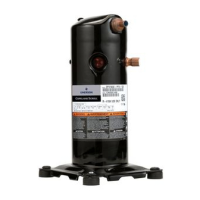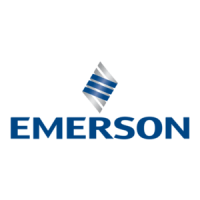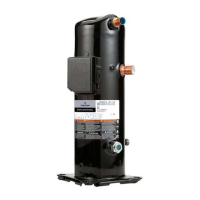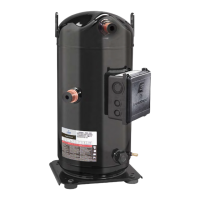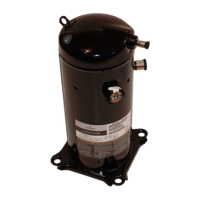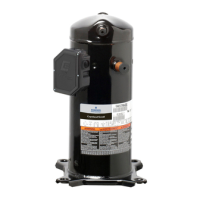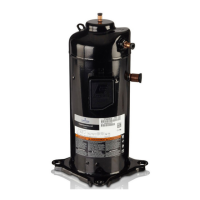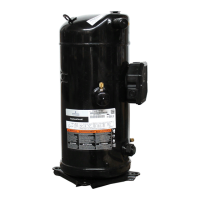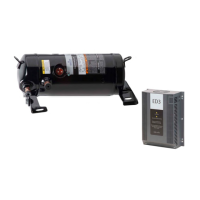8
© 2016 Emerson Climate Technologies, Inc.
AE4-1303 R15
of 20-25 in-lb (2.3-8 N-m) to ensure adequate contact
and to prevent heater burnout. Never apply power to
the heater in free air or before the heater is installed
on the compressor to prevent overheating and burnout.
WARNING! Crankcase heaters must be properly
grounded.
Pump Down Cycle
A pump down cycle for control of refrigerant migration
is not recommended for scroll compressors of this
size. If a pump down cycle is used, a separate
discharge line check valve must be added. The scroll
compressor’s discharge check valve is designed to stop
extended reverse rotation and to prevent high-pressure
gas from leaking rapidly into the low side after shut off.
The check valve will in some cases leak more than
reciprocating compressor discharge reeds, normally
used with pump down, causing the scroll compressor to
recycle more frequently. Repeated short-cycling of this
nature can result in a low oil situation and consequent
damage to the compressor. The low-pressure control
differential has to be reviewed since a relatively large
volume of gas will re-expand from the high side of the
compressor into the low side after shut down. Pressure
control setting: Never set the low pressure control
to shut off outside of the operating envelope.
The low pressure control should be set to open
no lower than 5 to 10F° (3-6K) equivalent suction
pressure below the lowest expected evaporating
temperature.
Reversing Valves
Since Copeland Scroll compressors have very high
volumetric efciency, their displacements are lower
than those of comparable capacity reciprocating
compressors. CAUTION Reversing valve sizing must
be within the guidelines of the valve manufacturer.
Required pressure drop to ensure valve shifting
must be measured throughout the operating range
of the unit and compared to the valve manufacturer's
data. Low ambient heating conditions with low ow
rates and low pressure drop across the valve can
result in a valve not shifting. This can result in a
condition where the compressor appears to be
not pumping (i.e. balanced pressures). It can also
result in elevated compressor sound levels. During
a defrost cycle, when the reversing valve abruptly
changes the refrigerant ow direction, the suction
and discharge pressures will go outside of the normal
operating envelope. The sound that the compressor
makes during this transition period is normal, and
the duration of the sound will depend on the coil
volume, outdoor ambient, and system charge level.
The preferred method of mitigating defrost sound is to
shut down the compressor for 20 to 30 seconds when
the reversing valve changes position going into and
coming out of the defrost cycle. This technique allows
the system pressures to reach equilibrium without the
compressor running. The additional start-stop cycles do
not exceed the compressor design limits, but suction
and discharge tubing design should be evaluated.
The reversing valve solenoid should be wired so
that the valve does not reverse when the system is
shut off by the operating thermostat in the heating
or cooling mode. If the valve is allowed to reverse at
system shutoff, suction and discharge pressures are
reversed to the compressor. This results in pressures
equalizing through the compressor which can cause
the compressor to slowly rotate backwards until the
pressures equalize. This condition does not affect
compressor durability but can cause unexpected sound
after the compressor is turned off.
System Screens & Strainers
Screens ner than 30x30 mesh (0.6mm openings)
should not be used anywhere in the system. Field
experiencehas shownthat nermesh screens used
to protect thermal expansion valves, capillary tubes, or
accumulators can become temporarily or permanently
pluggedwithnormalsystemdebrisandblocktheow
of either oil or refrigerant to the compressor. Such
blockage can result in compressor failure.
Contaminant Control
Copeland Scroll
™
compressors leave the factory with
a miniscule amount of contaminants. Manufacturing
processes have been designed to minimize the
introduction of solid or liquid contaminants. Dehydration
and purge processes ensure minimal moisture levels
in the compressor, and continuous auditing of lubricant
moisture levels ensures that moisture isn’t inadvertently
introduced into the compressor.
It is generally accepted that system moisture levels
should be maintained below 50 ppm. A lter-drier is
required on all POE lubricant systems to prevent
solid particulate contamination, oil dielectric
strength degradation, ice formation, oil hydrolysis,
and metal corrosion. It is the system designer’s
responsibility to make sure that the lter-drier is
adequately sized to accommodate the contaminants
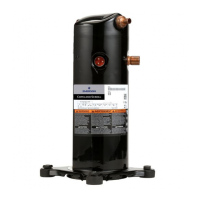
